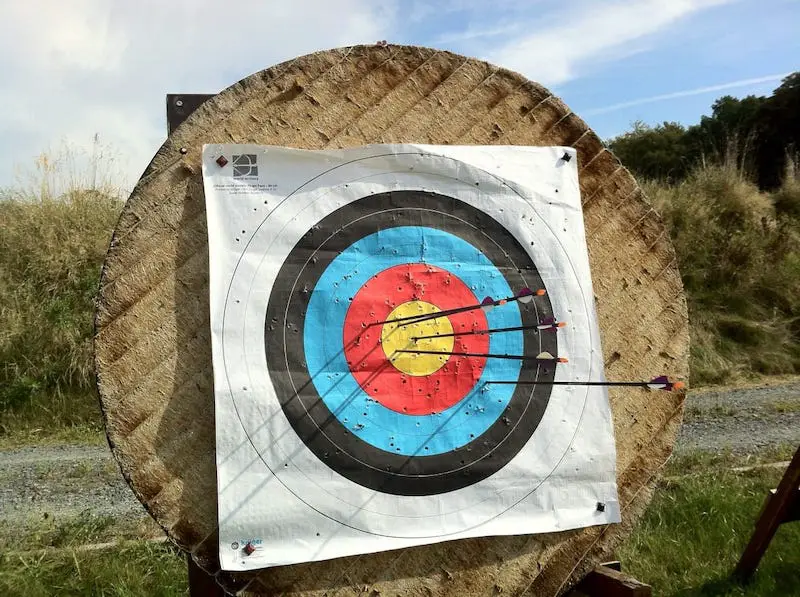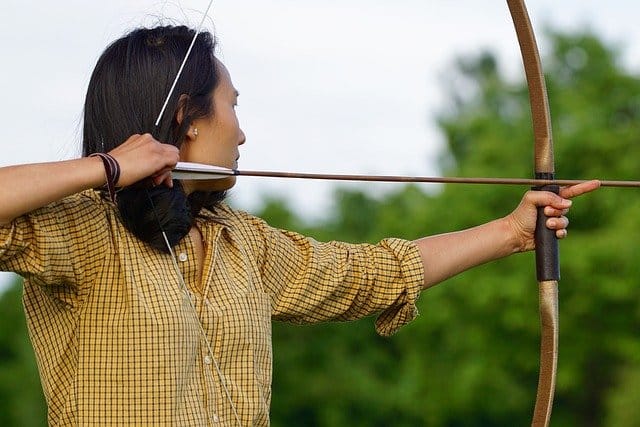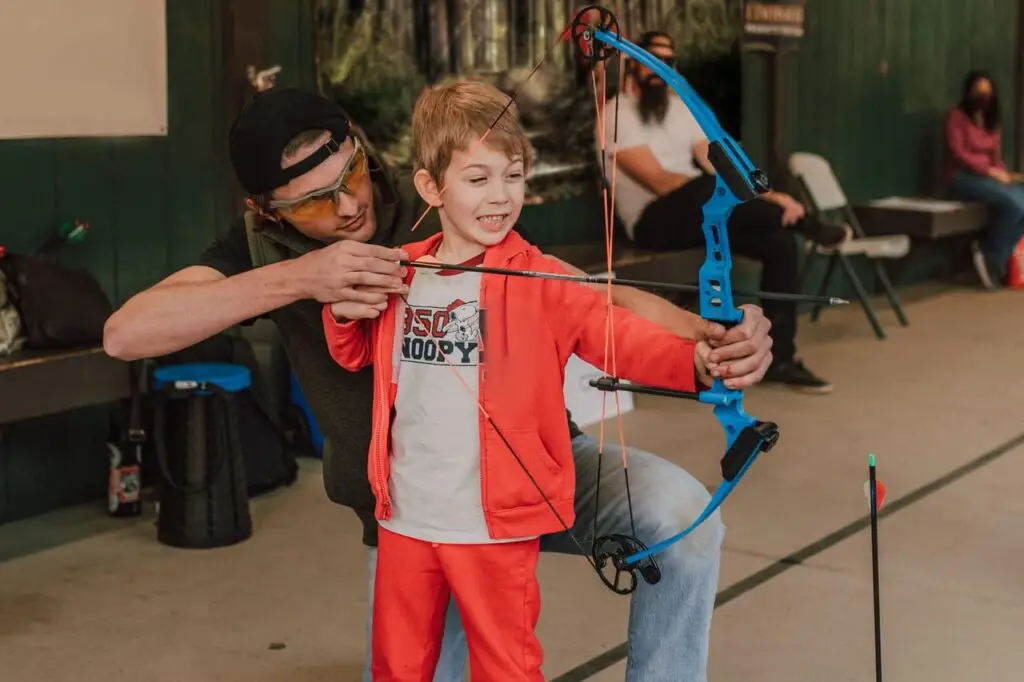When practising your archery, you’d like to think you’re skilled enough to hit your target every time with ease. Of course, the reality isn’t so favourable, and you’re going to find that every now and again, an arrow strays off target and headed for the horizon. The best way to prevent this is with an archery backstop, which is often made of wood, foam, or even hay, but will a budget-friendly tarp do the trick?
Tarps can be used as an archery backstop if you need a low-cost option to merely prevent your arrows from flying into the distance. However, there are many reasons why they are not the optimal choice for your archery backstops, such as broken arrows and other arrow damage and minimal durability. Ultimately, there are better alternatives, even for the same cost.
In this article, we’ll discuss why tarps maybe aren’t the best archery backstop compared to alternative products. We’ll also list some of those alternatives, so you can weigh your options and make an informed decision as to which backstop material is best for your equipment and budget.

Why You Shouldn’t Use Tarps as an Archery Backstop?
Many beginner or intermediate-level archers face the challenge of acquiring all the equipment they need to be skilled at this sport, which can be an extremely pricey endeavour. Therefore, we don’t blame them for looking at a $100+ state-of-the-art archery backstop net and assume a durable mesh tarp (that is substantially cheaper) will have the same effect.
Although tarps might appear similar to an archery net at first glance, they are a far inferior choice for your archery backstop for two reasons. The first is that they can cause significant damage to your arrows, even broken arrows, and the second is that they aren’t usually very durable against these arrows, resulting in minimal longevity.
Ideally, your archery backstop should be made of a material that is strong enough to stop your arrow’s flight progression but soft enough to not inflict damage on the arrowhead when it contacts the backstop.
There is a lot of speed and force behind your arrow when you shoot it, and so, if it collides with a rough or abrasive material, you’re going to wear down the tip of the arrow. As a result, you might find you’re spending more on arrow replacements than the tarp backstop was worth, so you aren’t really saving any money with this option.
Another issue with the tarp backstops is that they aren’t the most durable, allowing your arrows to shred them to pieces over time, which also defeats their purpose as a backstop. Of course, the tarps that are durable will almost certainly cause damage to your arrow. All around, it’s best to avoid this option.
Read: Setting up an indoor archery range?
Best Archery Backstop Options
After learning that tarps aren’t the ideal choice for your archery backstop, you might be left wondering what you can buy instead that won’t jeopardize your arrows’ integrity. Many of you might also be concerned about how much these alternatives cost, especially compared to a $10-$30 tarp. Don’t worry; we’ve got you covered!
The best backstop options for archery include:
- Carpet
- Hay bales
- Horse stall mats
- Archery backstop netting
- High-density fiber cloth
Each of these options has its own pros and cons that might warrant one the most suitable choice for you compared to others. To help you decide which one that is, we’ve briefly described all of these archery backstop options below.
You’ve read about the best archery backstop options. Now read about the best materials for DIY archery targets.
Carpet
It might seem odd at first glance, but carpets are actually one of the most commonly used backstop materials for archery. This is thanks to their immense durability paired with their soft material that is certain to cushion and halt your arrow’s progression without causing unnecessary damage or broken arrows.
Many archers will string up the carpet on an archery wire and place two or three in front of one another for additional support as a backdrop.
Ideally, you can use any old scraps of carpet you might have lying around, but if this isn’t an option, you can simply purchase a cheap carpet from your closet’s home improvement retailer. While it won’t be as cheap as a tarp, it will undoubtedly last longer and save you the cost of replacing arrows.
Hay Bales
Do hay bales make a good backstop? Another archery backdrop option you might not think of initially is hay bales. In our opinion, this is the most budget-friendly option of any listed here.
Hay bales have been used as archery backstops for centuries, and they’re still as effective today. Typically, one thick hay bail can do the work of two or three carpets, as they are dense but still aerated and soft enough to allow arrows to pass through and stop unscathed.
The best way to use hay bales as archery backdrops is to buy several and stack them on top of one another behind your target. Their only issues are that you’ll need to purchase several hay bales to cover the same area as a carpet or net, and you’ll have to properly maintain/store this backstop material to make sure it doesn’t grow dangerous mould or other unpleasant bacteria.
Horse Stall Mats
If you want a backdrop material that is going to be reliably sturdy, can cover a wide area, and won’t require multiple layers, then horse/stall mats are a fantastic option.
While this is a pricier option, with larger mats ranging from $30 to $70, it is undoubtedly one of the most effective archery backstops. These mats are typically made of recycled rubber crumbs or high-density EVA foam, allowing them to easily endure the impact of numerous arrows for ultimate longevity. There is also little concern that this dense but soft material will dent or scrape your arrow tips.
Most archers that opt for this material will nail it into a large wooden frame behind their target for additional stability rather than trying to hang it.
Netting for Archery Backstop
If budget isn’t a limit for you, we highly recommend you purchase a high-quality archery backstop net. As indicated by the name, these nets are ingeniously created specifically for the task of preventing your arrows from flying off into the distance when you miss the target.
The material used for these nets will provide optimal resistance upon impact to stop your arrow but are also usually weather resistant, so you can hang them with ease and leave them outdoors indefinitely as opposed to other options, like the hay bales.
Top-of-the-line archery backstop nets will generally cost you around $100-$150, making them a hefty investment for some hobbyist archers. However, they are, without a doubt, one of the best investments to make if you want to make one purchase for your archery backstop and not have to worry about it again for several years.
Netting can be an effective way to catch arrows while also providing a level of safety. However, there are a few things to keep in mind when using netting as an archery backstop.
First, the netting must be made of a material that can withstand the force of an arrow.
Second, it should be installed securely so that it does not move or shift when arrows strike it.
Finally, the netting should be placed at a suitable distance from the shooting line to ensure that arrows do not overshoot the target. With proper care and installation, netting can make an excellent archery backstop.
High-Density Fiber Cloth
You can also use a high-density fiber cloth as archery backstop or netting. The fiber cloth helps to absorb the impact of arrows, preventing them from damaging surrounding property or injuring bystanders. The netting, or fiber cloth, will be taking care of stray arrows.
High-density fiber cloth is an ideal material for a backstop, as it is durable and offers excellent arrow resistance. In addition, high-density fiber cloth is relatively lightweight and easy to transport, making it a good choice for archers who travel to different shooting locations.
Finally, high-density fiber cloth is available in a variety of colors, allowing archers to customize their backstop to match their personal style. Whether you are a recreational archer or a competitive shooter, a high-density fiber cloth backstop can help you enjoy your sport while staying safe.
Building a DIY Archery Backstop
Many archers choose to build their own DIY archery backstop to save money. Buying a pre-made backstop can be expensive and may not fit your specific needs. Building your own backstop allows you to customize the size, shape and materials used to create a backstop that is tailored to your space and budget.
Building a homemade backstop can be a fun and rewarding project – and money-saving. It can also allow you to be more creative with the design and construction of the backstop, giving you the freedom to experiment with different materials and techniques. Read about the best material for a DIY backstop.
So, overall, building your own DIY archery backstop is a great way for you to save money while having the ability to create a custom backstop that is perfect for your needs.
Final Thoughts
To all of you penny-pinching archers, we understand the appeal of using a basic tarp as your archery backstop, but we kindly ask that you steer clear from this low-quality and damage-inducing product and, instead, opt for one of the alternatives we’ve listed here. All of the options we discussed in this article are used by archers worldwide and will suit your needs far better than any basic tarp.


